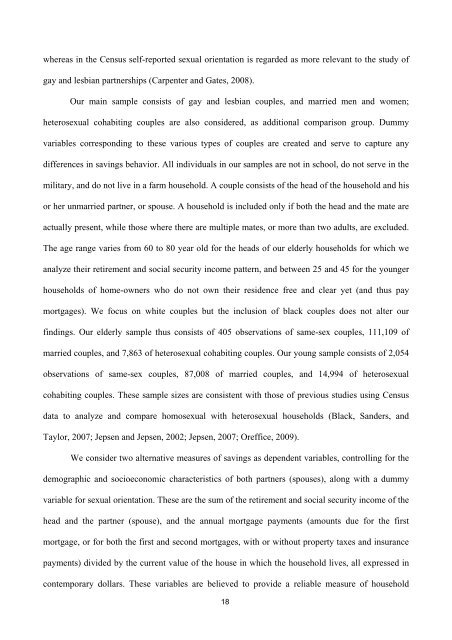Download PDF - Ivie
You also want an ePaper? Increase the reach of your titles
YUMPU automatically turns print PDFs into web optimized ePapers that Google loves.
whereas in the Census self-reported sexual orientation is regarded as more relevant to the study of<br />
gay and lesbian partnerships (Carpenter and Gates, 2008).<br />
Our main sample consists of gay and lesbian couples, and married men and women;<br />
heterosexual cohabiting couples are also considered, as additional comparison group. Dummy<br />
variables corresponding to these various types of couples are created and serve to capture any<br />
differences in savings behavior. All individuals in our samples are not in school, do not serve in the<br />
military, and do not live in a farm household. A couple consists of the head of the household and his<br />
or her unmarried partner, or spouse. A household is included only if both the head and the mate are<br />
actually present, while those where there are multiple mates, or more than two adults, are excluded.<br />
The age range varies from 60 to 80 year old for the heads of our elderly households for which we<br />
analyze their retirement and social security income pattern, and between 25 and 45 for the younger<br />
households of home-owners who do not own their residence free and clear yet (and thus pay<br />
mortgages). We focus on white couples but the inclusion of black couples does not alter our<br />
findings. Our elderly sample thus consists of 405 observations of same-sex couples, 111,109 of<br />
married couples, and 7,863 of heterosexual cohabiting couples. Our young sample consists of 2,054<br />
observations of same-sex couples, 87,008 of married couples, and 14,994 of heterosexual<br />
cohabiting couples. These sample sizes are consistent with those of previous studies using Census<br />
data to analyze and compare homosexual with heterosexual households (Black, Sanders, and<br />
Taylor, 2007; Jepsen and Jepsen, 2002; Jepsen, 2007; Oreffice, 2009).<br />
We consider two alternative measures of savings as dependent variables, controlling for the<br />
demographic and socioeconomic characteristics of both partners (spouses), along with a dummy<br />
variable for sexual orientation. These are the sum of the retirement and social security income of the<br />
head and the partner (spouse), and the annual mortgage payments (amounts due for the first<br />
mortgage, or for both the first and second mortgages, with or without property taxes and insurance<br />
payments) divided by the current value of the house in which the household lives, all expressed in<br />
contemporary dollars. These variables are believed to provide a reliable measure of household<br />
15

















